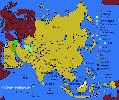|
|
|
|
|
|
|
|
|
|
|
|
|
|
| | |
|
|
|
|
| | |
| Name | latin |
Odontomantis micans |
| english |
Ant Mantis |
| |
|
| | Systematics | Super-Order |
Dictyoptera |
| Order |
Mantodea |
| Family |
Hymenopodidae |
| Subfamily |
Acromantinae |
| Tribe |
Acromantini |
| |
|
| | First Description | Author |
SAUSSURE |
| Year |
1871 |
| |
|
| Size
Quotation of Size
|
|
The given size is measured from the head to the end of the abdomen, without the wings.
|

|

| Male |
ca. 1,5cm |
| Female |
ca. 2,4cm |
| |
|
| Lifespan
Quotation of the Lifespan
|
|
The lifespan is given in month and has the following definition:
overall-age ("time between hatching and imago" + "lifespan after the last molting")
Example: 9 (2 + 7) month lifespan
overall-age = 9 month
time between hatching and imago = 2 month
lifespan after the last molting = 7 month
|

|

| Male |
ca. 5 (2,5 + 2,5) months / ~ 6 moltings |
| Female |
ca. 6,5 (2,5 + 4) months / ~ 7 moltings |
| |
|
| Sexing
Sexing
|
|
Morphologically differences between male and female.
|

|

| Male |
L5 and above: just by counting the abdominal- segments (8 Segments)
adult: smaller and thinner than females, otherwise by counting the abdominal- segments |
| Female |
L5 and above: just by counting the abdominal- segments (6 Segments)
adult: bigger and more compact than females, otherwise by counting the abdominal- segments |
| |
|
| | | | | Spreading | India, Sri Lanka, Thailand, Sumatra, Borneo, Sunda Islands |
| The description of this species is based on individuals of the following origin:
Pak-Chong (Thailand) |
| |
| |
|
| |
 |
| Asia |
|
| | Habitat | bushes
inhabits damp and warm areas |
| |
|
| | Aggressiveness | low |
| |
|
| | Colorvariants | none |
| |
|
| | Hint | mimics ants in look and behaviour perfectly,
take care for good ventilation and no stagnant moisture |
| |
|
|
| |
|
|
|
|
|
|
|
|
|
